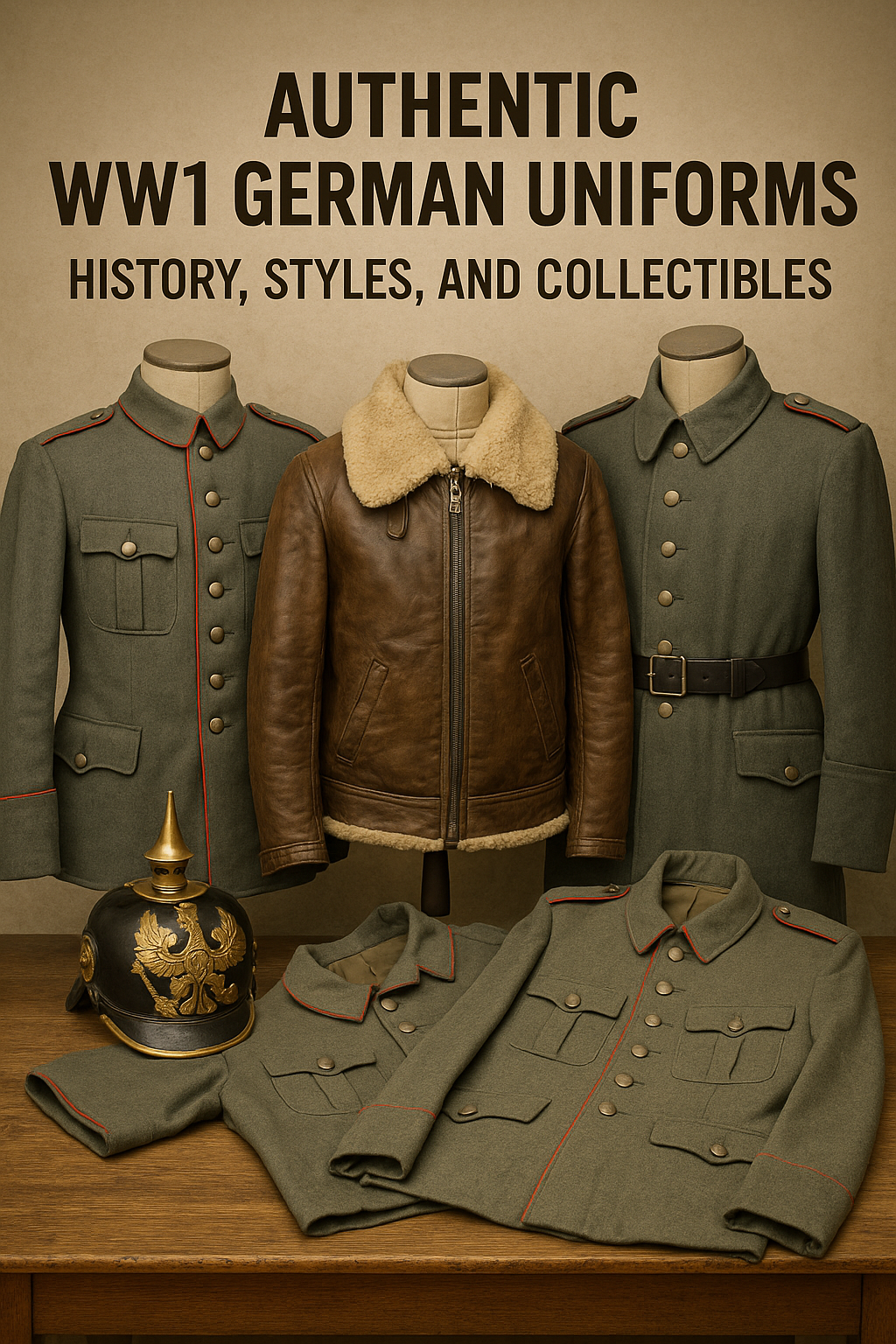
Authentic WW1 German Uniforms: History, Styles, and Collectibles
Published on Jul 02, 2025
WW1 German Uniforms: A Complete Guide to Jackets and Gear
Regarding military history, few things captivate enthusiasts like the intricately designed and historically significant WW1 German uniforms. These uniforms not only served functional purposes during the Great War but also became symbolic of the German military's identity and discipline. Today, collectors and reenactors continue seeking authentic WW1 German jackets, tunics, and gear to preserve and relive history.
In this guide, we break down the key elements of WWI German uniforms, from the iconic WWI tunic to pilot jackets and gear, while also linking them to related pieces from WW2, like German shoulder boards and other German WW2 gear.
The Origins of the WW1 German Uniform
The onset of World War I in 1914 marked the evolution of military uniforms from bright and decorative to practical and camouflaged. The Imperial German Army adopted the feldgrau (field gray) uniform as a standard. This muted tone was designed to blend with the battlefield environment and reflected the shift towards more strategic and less decorative warfare.
Key Components of the WW1 German Uniform
1. The WW1 German Tunic (Feldbluse)
The WW1 German tunic, or Feldbluse, was the centerpiece of the soldier’s uniform. Typically made of wool and dyed in feldgrau, it featured:
- A stand-and-fall collar
- Pleated pockets
- Cuffs with Swedish-style designs
- Colored piping to denote regiments
Officers’ versions often had finer tailoring and sometimes featured hidden pockets or internal belts.
🔍 SEO Keyword Focus: ww1 German tunic
At Paddelaters.com, we offer meticulously crafted reproductions of WW1 German tunics modeled after historical patterns for authenticity.
2. WW1 German Jacket
Often used interchangeably with the tunic, the WW1 German jacket also referred to outer layers like trench coats or storm jackets worn during harsh battlefield conditions. These garments prioritized durability and warmth, often layered over the Feldbluse.
🔍 SEO Keyword Focus: ww1 German jacket
Collectors seek these jackets for their robust construction and historical value. They remain one of the most recognizable pieces of WW1 German militaria.
3. The WW1 Pilot Jacket
A separate but highly sought-after category is the WW1 pilot jacket, worn by German aviators. Made from thick leather or sheepskin, these jackets offered warmth at high altitudes and became fashion statements even after the war.
Common features include:
- Fur lining
- Double-breasted closures
- High collars
- Zipped or buttoned pockets
🔍 SEO Keyword Focus: ww1 pilot jacket
These jackets symbolize the daring and elite nature of WW1 German pilots and are a favorite among vintage fashion enthusiasts and collectors alike.
Accessories and Gear That Completed the Uniform
While jackets and tunics were central, the full WW1 German uniform included accessories that defined rank, unit, and function.
Shoulder Boards and Insignia
Shoulder boards, known as epaulets, identified a soldier’s rank and regiment. Though more commonly associated with WW2, their roots trace back to WW1 designs.
🔍 SEO Keyword Focus: German shoulder, WW2 German shoulder boards
At Paddelaters.com, we offer WW1 and WW2 German shoulder boards crafted to reflect original detailing.
Helmets (Pickelhaube and Stahlhelm)
The Pickelhaube, a spiked leather helmet, was initially used but was soon replaced by the Stahlhelm, which provided better protection against shrapnel and bullets.
Belts, Boots, and Gear
- Leather belts with brass buckles engraved with “Gott Mit Uns.”
- Jack boots for cavalry and high-ranking officers
- Bread bags, canteens, and ammo pouches
Transition to WW2 Gear
While the focus is WWI, many design elements, including the muted color palette, shoulder boards, and rugged construction, carried over into German WW2 gear.
Understanding this continuity helps collectors and reenactors appreciate the evolution of German military apparel. Our German WW2 gear collection complements WW1 pieces for those looking to compare styles or expand their collection.
Why Collect WW1 German Uniforms?
1. Historical Value
Each uniform tells a story—of battle, survival, and the men who wore them. Owning a piece is like holding a fragment of living history.
2. Craftsmanship
Military tailors of the early 20th century put exceptional skill into each piece, making them unique works of textile art.
3. Reenactment & Education
Whether for museums, schools, or battlefield reenactments, these uniforms serve an educational purpose, helping audiences visualize and connect with history.
Tips for Buying Reproduction WW1 German Uniforms
- Check Authenticity: Look for historical accuracy in design, materials, and construction.
- Choose Reputable Sellers: Buy from trusted sources like Paddelaters.com to ensure quality.
- Understand Your Needs: Are you buying for display, wear, or collection? This affects the type and size you need.
- Match Accessories Properly: Use the correct shoulder boards, belts, and boots to complete the look authentically.
Why Buy from Paddelaters.com?
At Paddelaters, we pride ourselves on providing:
- Historically accurate WW1 and WW2 reproductions
- Durable materials and professional tailoring
- A wide selection, from tunics to pilot jackets and shoulder boards
Whether you're a first-time buyer or a seasoned collector, we help you bring history to life—one uniform at a time.
Conclusion
The WWI German uniform is more than just clothing—it’s a symbol of a turbulent past and a tribute to history. From the classic Feldgrau tunic to the iconic WWI pilot jacket, each piece offers a tangible link to the soldiers of the Great War.
